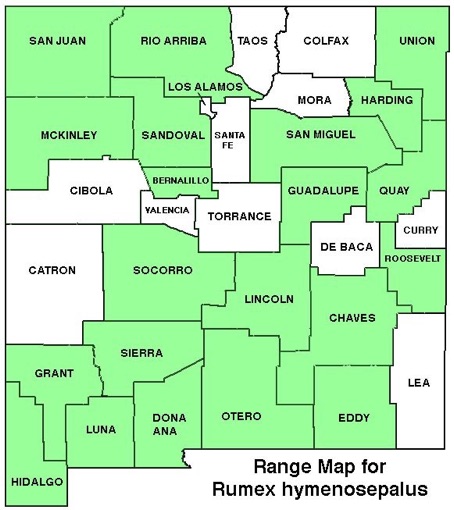WILDFLOWERS OF NEW MEXICO

In early spring a basal rosette of large, elliptic, gray-green leaves sprouts from tubular roots in sandy waste places, often where a little runoff is evident. Note the stout stem 12–40-inches tall with a dense cluster of yellowish to bright red flowers and seed capsules on the upper half. By late summer, often only the brown, withered basal leaves remain. All parts have traditional edible, medicinal, and useful properties. Young leaves reportedly make nutritional potherb but are high in oxalic acid, harmful in large quantities. Roots are high in tannin.
FLOWERS: February–April, showy seeds through July. Flowers in dense spike-like whorls along erect stem; flower to 1 1/4-inches wide (30 mm) with 6 pinkish-green tepals 7/16–5/8-inch long (11–16 mm). The 3 inner tepals develop into 3 showy reddish-brown, paper-like disks, each with a tiny embedded seed.
LEAVES: Basal and alternate stem leaves. Basal leaves broadly lance-shaped to 12-inches long (30 cm). Stem leaves smaller, narrower.
HABITAT: Sandy, rocky soils, plains, dunes, drainages, disturbed areas; desert scrub and grasslands, plains, foothills.
ELEVATION: 4,100–7,000 feet.
RANGE: AZ, CA, CO, NM, NV, TX, UT, WY.
SIMILAR SPECIES: 20 species of Rumex in NM, 13 that produce basal rosettes, many species separated by tepal features and rootstock. The introduced Curly Dock, H. crispus, statewide, has lance-shaped basal and stem leaves to 2-inches wide with undulate margins. The widespread White Dock, R. triangulivalvis, has no basal leaves and long, narrow stem leaves to 1 1/2-inches wide (4 cm) with indistinct bottom veins.
NM COUNTIES: Widespread in low- to mid-elevation sandy habitats: Bernalillo, Chaves, Dona Ana, Eddy, Grant, Guadalupe, Harding, Hidalgo, Lincoln, Luna, McKinley, Otero, Quay, Rio Arriba, Roosevelt, San Juan, Sandoval, Sierra, Socorro, Union.









DOCK, CANAIGRE
RUMEX HYMENOSEPALUS
Buckwheat Family, Polygonaceae
Perennial herb









THE CONTENTS OF THIS WEBSITE ARE COPYRIGHTED AND CANNOT BE USED
WITHOUT PERMISSION OF GEORGE OXFORD MILLER












































The fruit has three reddish, papery wings, each with a tiny seed.








EMAIL ME







